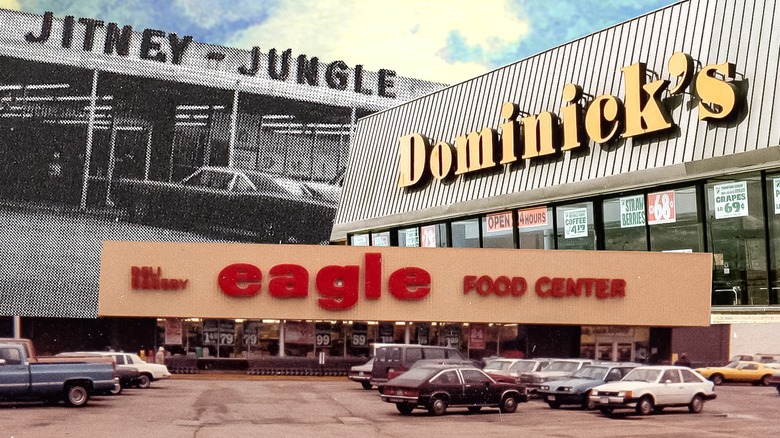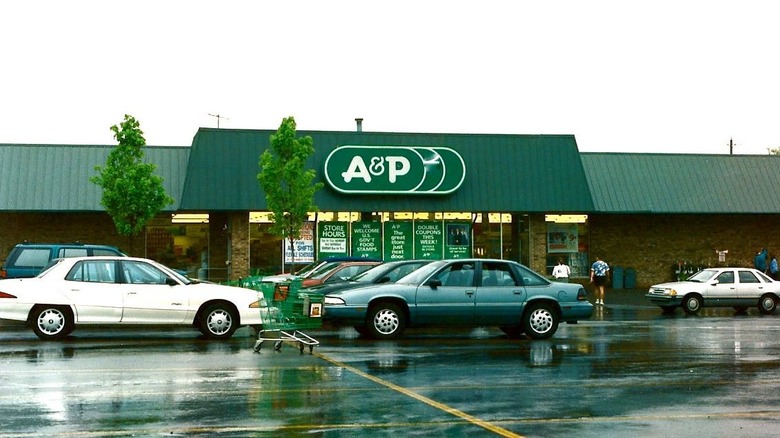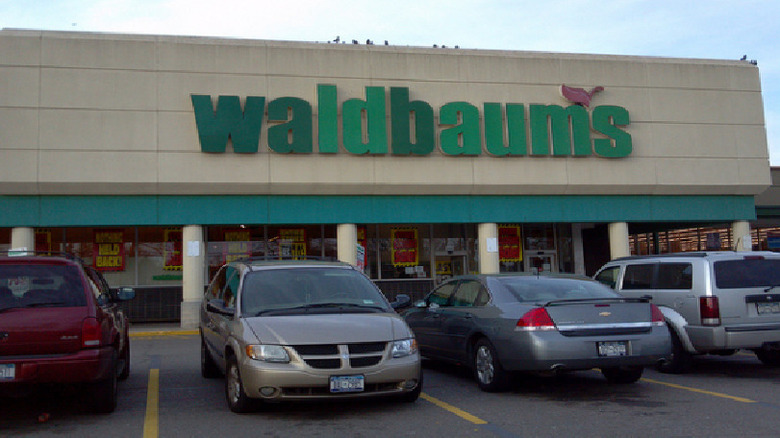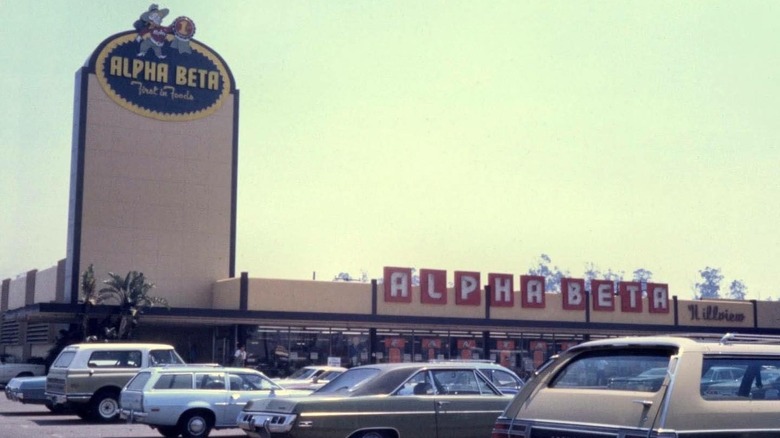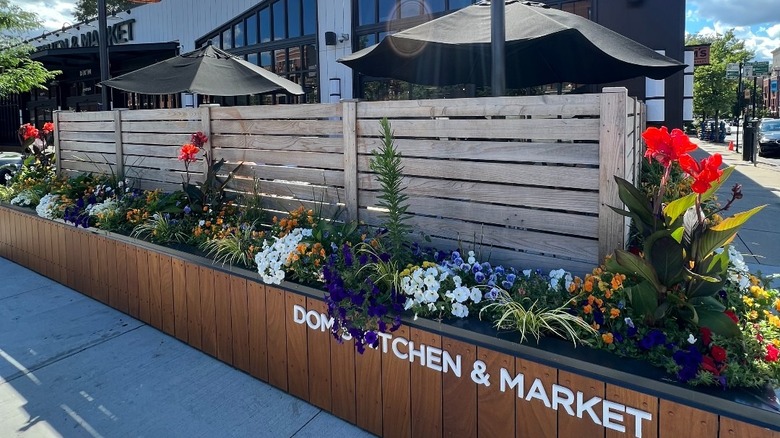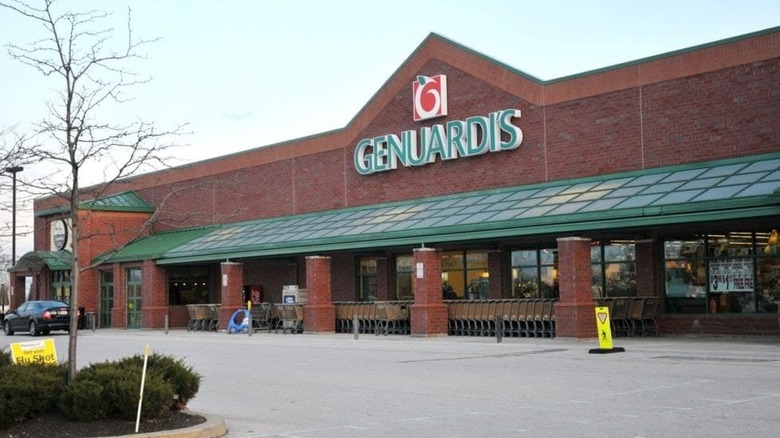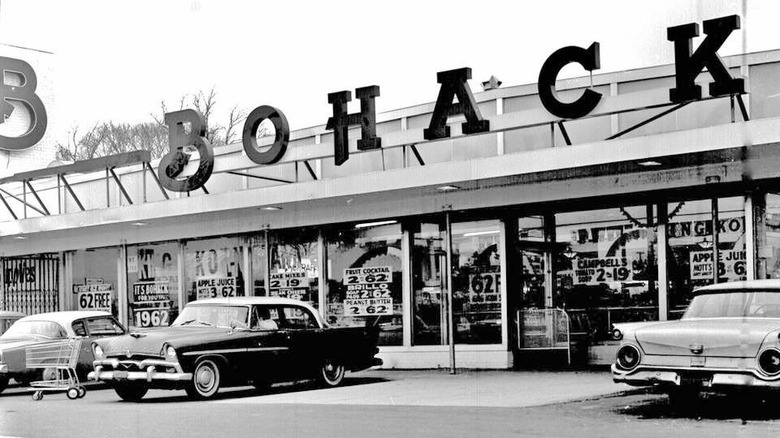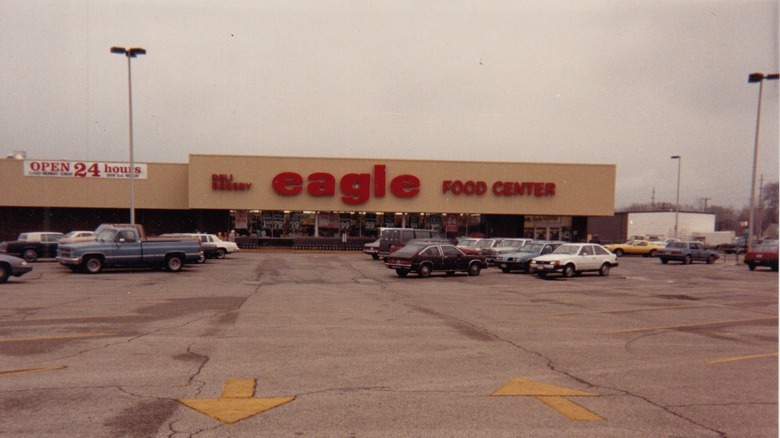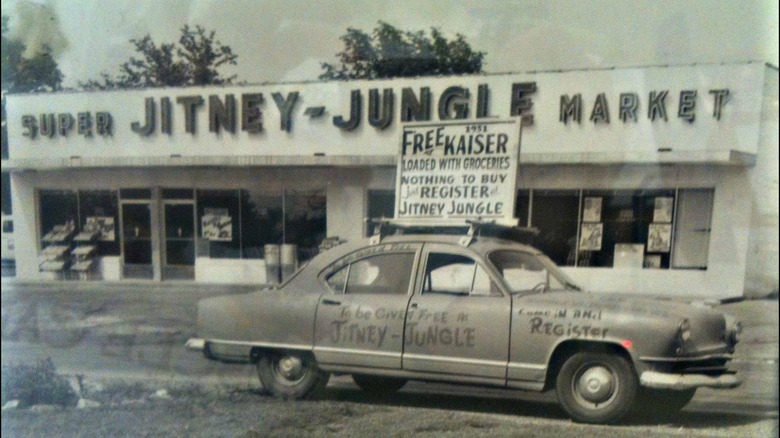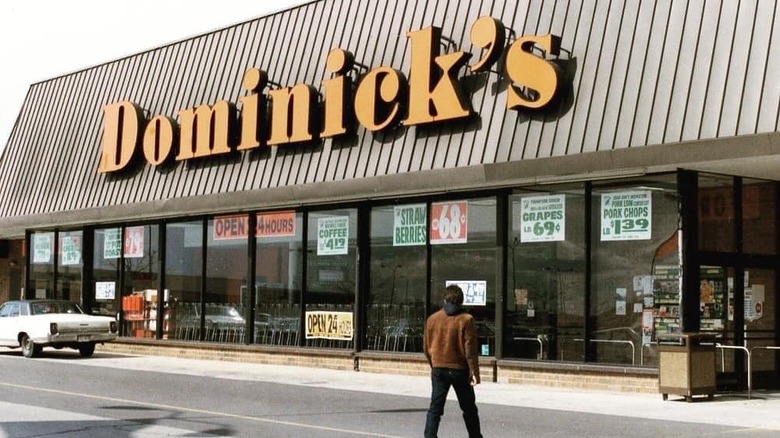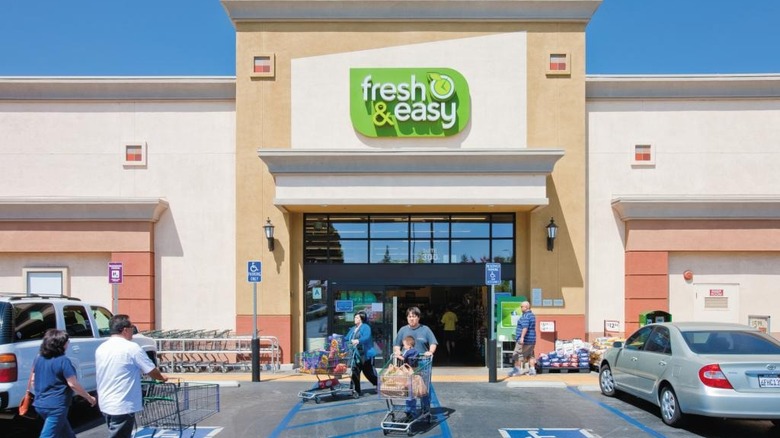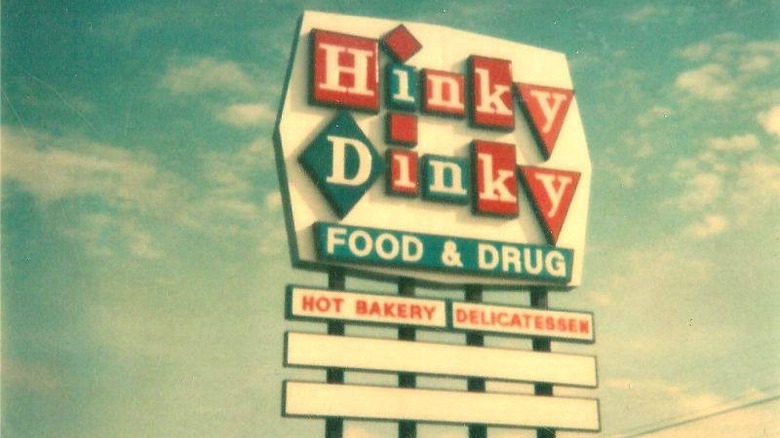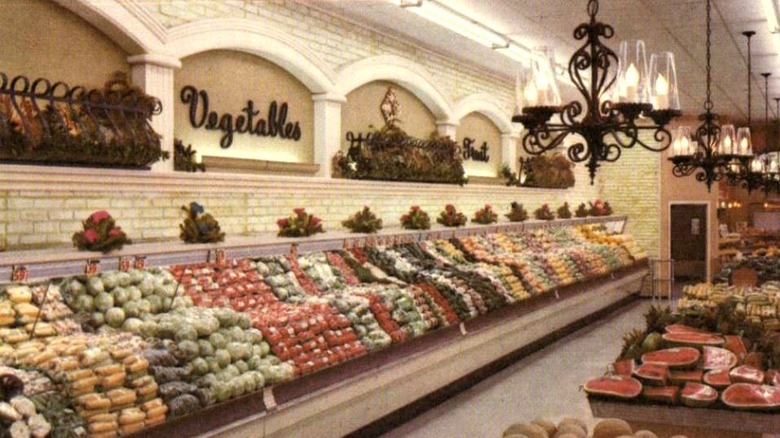12 Forgotten Grocery Stores That Should Still Exist Today
Currently, in the United States, the top four supermarkets are Albertson's, Costco, Kroger, and Walmart, with the latter easily claiming the top spot in sales. Walmart accounts for more than 25% of all grocery sales within the country. A lot of acquisitions and mergers have led the supermarket arena to become somewhat consolidated, but it didn't always used to be that way.
If you grew up in the '80s or '90s (or earlier), you may remember some other famous grocery store names that are no longer around. These aren't just mom and pop shops either, though a lot did start as family-owned businesses.
Some stores used to be massive regional or national chains, seemingly too big to ever fail, and still ended up going bankrupt and shuttering or selling all their locations in the last few decades. However, a lot of them are still very memorable to those who used to frequently shop or work there, as they either had very good reputations or came up with new philosophies or strategies that affected how supermarkets worked in general.
A&P
Perhaps the most recognizable and massive grocery chain to go defunct, A&P — which stands for The Great Atlantic & Pacific Tea Company — was founded in 1859 in NYC. It was once the biggest grocery store in the U.S., dominating the business for most of the 20th century, to the point where from the 1920s to the 1960s it was the largest retailer in the world, with almost 16,000 locations. Unfortunately, it started to decline in the last few decades of the century, and in 2015, it officially declared bankruptcy and closed or sold off all its stores nationwide.
So, what happened? Well, part of what made A&P successful was the fact that the Hartford brothers who ran it for the first half of the 20th century used innovative methods to keep prices low and drive out competition. Then, both brothers died in the 1950s, and with them, the mindset for radical innovation and change vanished. Though many of A&P's customers were moving out of the cities and into the suburbs, the chain refused to expand along with them, and barely even touched the West Coast market, even as the population there boomed. Eventually, the supermarket lost a lot of its customer base and its competitive advantage, leading it to become defunct.
Waldbaum's
Residents of the tri-state area, especially Long Island, will probably be familiar with Waldbaum's. Two Jewish-Ukrainian brothers, immigrants to the U.S., established the supermarket chain as a family-run business in 1904. The Waldbaum's eventually sold their business to A&P in 1986. Unfortunately, that meant that when A&P declared bankruptcy, Waldbaum's fate was tied to it, and all stores shuttered.
Waldbaum's was one of the most open-minded and progressive supermarkets when it came to hiring practices at the time. Though it was established in white neighborhoods initially, the personnel the Waldbaum brothers hired included two Black twins, Ernest and George Brown, all the way back in 1938. Though segregation was still very much active throughout the country, the theme of brothers and family in business persisted throughout the chain. The twins were promoted to checkout, and later on, became company executives.
This family-run, touch-and-open hiring practices (while also selling products from different cultural cuisines), made Waldbaum's incredibly popular in multiethnic neighborhoods around NYC. However, when A&P bought it out, the company rapidly declined. Most of the Waldbaum family's descendants were pushed out of management, the stores were neglected — 47% failed a sanitation inspection by NYC in 1990 — and the diverse range of products disappeared. Even though it was a regional chain, it was the 12th biggest supermarket chain in the U.S. when it was bought out, and its decline under A&P was shocking.
Alpha Beta
All the way on the other side of the country, on the West Coast in 1917, the Gerrard brothers started Alpha Beta by purchasing local dry good markets and adding produce and groceries. These supermarkets were special for the time because inventory wasn't just limited to groceries; in the '70s and '80s, some Alpha Betas sold Atari computers and color TVs. Alpha Beta stores were famous for using Looney Tunes characters in commercials, and attaching the slogan "tell a friend" numerous advertisements.
Part of what made Alpha Beta special was its emphasis on community. Unlike many other chains, it had started in the suburbs, giving it a special place as a community touchstone among a subset of suburban consumers who were rapidly growing in size. Unfortunately, after a hostile takeover in 1979, the company's popularity with customers started to decline. Then, due to a merger and several acquisitions, the latest by Ralph's, the stores were either shut down or swallowed up by Ralph's after they were acquired.
Outfox Hospitality
If you don't recognize this brand name, it's because Outfox Hospitality was the name of a short-lived merger between Foxtrot and Dom's Kitchen and Market. The two companies, both upscale, gourmet grocery stores that specialized in gourmet produce, such as organic wines and fresh baked goods, merged at the end of 2023, and suddenly imploded in April of 2024. This came as a shock to customers who frequented what seemed to be thriving stores with high-quality products.
The strange thing about this closure is the speed with which it happened. Stores were ordered to shut by noon, with employees and customers mostly in the dark, and customers still shopping when the company closed its locations. Suppliers were caught off guard, with one actually filing a lawsuit against Outfox for the complete lack of notice. With rumors that Foxtrot may be returning on its own, market observers still aren't 100% what happened to lead to this abrupt closure, but it's safe to say the merger played a large part in it.
Genuardi's
The Genuardi family started out in 1920 by selling produce from their farm in Pennsylvania, with Gaspare Genuardi roaming across the area in a horse-drawn wagon and cart. Eventually, the family business became so popular and successful that the Genuardis opened their first full grocery store in Norristown, PA, in 1954.
The grocery stores went through three generations of Genuardi management until it was acquired by Safeway in 2001. After that, the reputation promptly plummeted, causing the stores to shut down one by one until the last remaining stores shuttered in 2015.
Previously, Genuardi's was known for having a lot of healthy produce and food options, including plenty of vegetarian-friendly choices. For people who loved the idea of fresh produce that was good for both their wallet and their health, Genuardi's was a dream. After the acquisition, customers complained that Safeway hiked prices, and apparently, the public preferred the caring touch that the family provided in their stores throughout the Northeast.
Bohack's
A staple of New York City and the surrounding areas in the 20th century after opening all the way back in 1887, Bohack's quietly disappeared from the grocery store arena in 1977. People loved Bohack's because the store focused on providing a sense of friendliness and community to customers. In the fast paced areas around NYC, this was a rare and welcome perk for a chain store.
Customers would swing by not only to shop, but to say hello to friends and family members who were working. In addition, Bohack's produced several of its store-brand groceries that people loved, including a store brand of cheesecake that was incredibly popular. Other such products, labeled "Bohack's Best," included apple sauces, white bread, fruitcake, coffee, and even beer.
So, what went wrong? Well, in what seems to be a recurring theme, expansions and acquisitions. The Bohack family took the chain public in 1965, and allowed Charles Bluedorn, head of Gulf and Western Industries, to become the majority stakeholder. An exceptionally ambitious man, Bluedorn had acquired a range of businesses including Paramount Pictures, Sega, Simon and Schuster, and even Madison Square Garden under his umbrella of companies. Unfortunately, this meant that when a big recession hit in the 1970s, a few of his businesses started going under, and since he was in essence part owner of Bohack's at the time, this had a domino effect that eventually shut down the supermarket chain.
Eagle Food Centers
This Midwestern chain of stores known as Eagle Food Center declared bankruptcy in 2000 and completely stopped operations in 2003; it found it could not compete against massive chains like Kroger and Walmart. The company's bankruptcy came as a sad surprise to local customers. Prior to its closing, Eagle Food Centers had a great reputation as a family-friendly and affordable supermarket among its customers in Iowa, Illinois, and Indiana.
Established in 1893 in Davenport, Iowa, the chain was notable for being one of the first grocery stores to understand the upside of self-service and allowing customers to utilize it in exchange for lower prices. However, the arrival of giant corporate (and national) supermarket chains signal a giant shift in the regional market.
Joe Lackey, president of the Indiana Grocery and Convenience Store Association, told the Times of Northwest Indiana that supermarket profit margins tend to be quite low, averaging around 0.7%. As he stated, "profit is so low that it takes little to push one out. When a new store comes into the market, they take away customers who rush to see what it has to offer ... the really large chains can handle market shifts better, because they have more stores to spread the loss."
Jitney Jungle
After the first Jitney Jungle store opened in Mississippi in 1919, run by three local families, new locations kept opening throughout the Southern U.S. "Jitney" was old slang for a nickel, and was meant to evoke the store's affordability to customers. The expansion process greatly accelerated when Syrian immigrants Pete and Bessie Nosser opened up the Big Jitney in Vicksburg. The extroverted and incredibly friendly owner, Mr. Pete, became something of a famous local figure.
In addition, this store revolutionized the way grocery stores at the time operated. Prior to the Big Jitney, supermarkets would only sell groceries, with clerks gathering up various items on their customers' list. The Nossers changed this concept and made the Big Jitney a full-service store. It included hot meals served at the counter, a pharmacy, cleaners, and several other services. Thanks in part to the ingenuity, Jitney Jungle skyrocketed in popularity and over 200 locations opened up in the South.
However, this prosperity would come to an unceremonious end when an investment firm bought the chain of grocery stores in 1996 and tried to expand too fast. It caused Jitney Jungle to file for bankruptcy in 1999, and close entirely in 2001, selling the last of its remaining stores off to Winn-Dixie.
Dominick's Finer Foods
Dominick DiMatteo opened his grocery store in 1918 in Chicago, where it quickly became famous for the quality of its produce. DiMatteo personally selected all produce from local markets before placing it in his store and selling it to customers. This grocery store should still be around, as it was a rare breed that combined premium quality with the concept of a one-stop shop, since Dominick's stores ended up offering everything from video rentals to photo development.
However, after Dominick DiMatteo Jr. died in 1993, his family sold off the business about a year later, since no one wanted to take it over. Though his son, James, had been running the business for some time, his father, Dominick Jr., was still involved and overseeing a lot of the operations while he was still alive.
The large supermarket chain Yucaipa ended up buying Dominick's Finer Foods, which operated 81 stores at the time, and after a few years, Safeway acquired it. Safeway switched the company's focus from "quality first, price second" to exactly the opposite. As a result, sales and customer satisfaction declined. Eventually, this lead to the closure of the last Dominick's on December 28, 2013.
Fresh & Easy
U.K. supermarket giant Tesco started opening up Fresh & Easy stores in the U.S. in 2007, and in a relatively short time frame expanded to over 200 locations. However, it shuttered and then sold off the last stores to Yucaipa in 2013. What caused this very quick ascent followed by a crash and burn in the market?
Well, part of the issue was timing. Right after Tesco opened up the first Fresh & Easy stores, the financial crash of 2008 occurred, leading people to spend less money than before. The other problem is that Tesco invested a ton of money into the expansion — around $1.5 billion — without adequately adjusting to different U.S. norms for supermarket shopping.
For example, Tesco hasn't account for the fact that U.S. shoppers, thanks to a car-centric culture, tend to shop less often but buy more each time. They also expect exceptionally friendly customer service. Customers complained that Fresh & Easy didn't have enough employees to give customers the attention they wanted, and often inventory wasn't available in stores. Whereas U.K. customers would simply return at another time for their items, U.S. customers rarely adjusted to this pattern of shopping.
Hinky Dinky
The first Hinky Dinky was opened in 1925 in Omaha, Nebraska, by local residents who quickly made it one of the most cutting-edge grocery stores of its time. Though it was initially known as "The Hink", it was eventually changed to Hinky Dinky after a World War I song titled "Hinky Dinky Parlez-vous", partly because the owners had noticed that competitor Piggly Wiggly got a lot of attention thanks in part to its cutesy name.
Hinky Dinky was among the first chains to implement automation, and the first chain in the area to use wheeled grocery carts. The store was also famous for its prized customer service and satisfaction. Hinky Dinkys were known to have little personal touches across stores, like mobile libraries in the parking lots and a partnership with First Federal Savings & Loan to provide banking services to customers shopping in-stores.
Unfortunately, in 1972, Cullum Cos. bought the chain and used the profits from the healthy business to support other stores, known as Tom Thumb markets. This caused Hinky Dinky to suffer, with most stores closing by 1985. The very last store with the Hinky Dinky name was purchased and rebranded in 2000. Had Hinky Dinky managed to exist today, one can only imagine the emphasis on innovation that it might have generated in the grocery sector.
National Tea
In the first half of the 20th century, the Midwestern chain National Tea grocery stores managed to survive the Great Depression to then become one of the top 10 grocery stores in the country. Established in 1899, National Tea, which would eventually go by the name National, developed a fresh-focused business model that brought produce from farmers straight to its stores so they could be sold there directly, instead of languishing in distribution warehouses first.
In its time, it meant that National Tea could sell fresher but more perishable items than many of its competitors, giving it an edge among customers who prized fresh food straight from the farm; a real farm-to-table concept before that idea had gained popularity. After being purchased and partly renamed a couple of times, many of the stores were eventually bought by James R. Gibson. Unfortunately for the future of National Tea, Gibson was found to have diverted millions of dollars in an unauthorized way, landing him in jail for 40 years and hastening the closure of National Tea's last remaining and renamed stores throughout the '70s and '80s. Unfortunately, though the model no longer exists, National Tea is one grocery that would do well with today's grocery shoppers.
